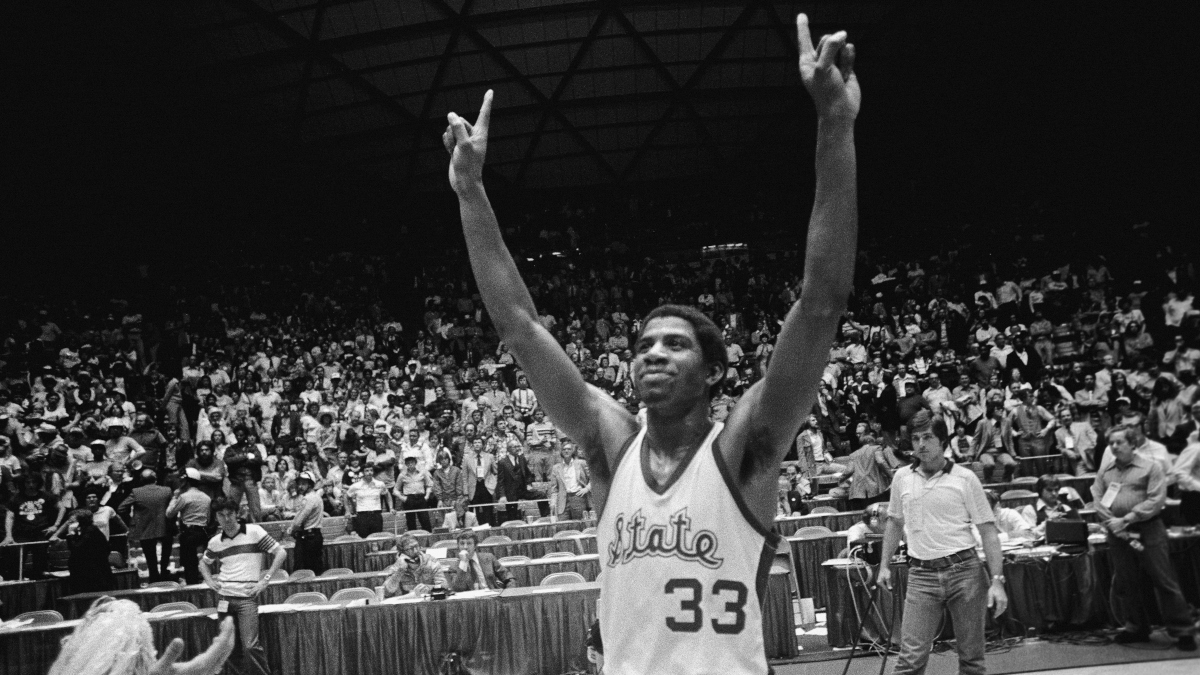NBA
What if the Lakers Don’t Take Magic Johnson? In a Parallel Universe, the NBA of the 1980s Looks Very Strange

The Los Angeles Lakers changed significantly in 1979. That year, with a gift courtesy of the beleaguered Utah Jazz, the Lakers were a 47-win team with the No. 1 overall pick in the NBA draft. History shows the Lakers took legendary Magic Johnson, Showtime was born under coach Pat Riley a few years later, and LA won five titles in the 1980s.
And it almost didn’t happen. Lakers assistant general manager Jerry West, who had coached the team the previous three seasons, wasn’t sure about Johnson’s future as a 6-foot-9 point guard. He recommended another player to owner Jack Kent Cooke. So what if West’s recommendation had turned into reality? The rabbit hole is intriguing.
Understanding how Magic Johnson fit in the 1979 NBA scene
In the modern era, it’s common for 19-year-olds to enter the NBA. But in 1979, teams weren’t drafting potential. No, NBA GMs wanted finished products to fill needs from draft classes mostly comprised of 21-, 22-, or even 23-year-old college seniors.
Having a pick at the top of the draft was a prime opportunity to strengthen a weakness or fill a vacancy. As dazzling as Magic Johnson was at Michigan State, there were questions about how the teenage sensation fit in the NBA.
Remember that the Lakers already had an established point guard at the time. Norm Nixon was a first-round pick in 1977. Magic didn’t take full reign of the LA offense until 1983 when the Lakers swapped Nixon to the San Diego Clippers for Byron Scott.
It’s also worth noting that 1979–80 was the NBA’s first season with the 3-point line. The most active 3-point shooting team in the league that season was the Clippers. They attempted 543 long bombs for the season. For perspective, consider that Stephen Curry has launched 203 in 15 games this season.
That is the lens for our trip to a parallel dimension where the Lakers passed on Magic Johnson.
With the 1st pick in the 1979 NBA Draft, the Lakers select …
If the theory of infinite parallel realities is true, somewhere, there’s an NBA in which the Lakers took West’s advice. With the first pick in the 1979 NBA Draft, LA went for the safe choice to fill a need at shooting guard. Arkansas star Sidney Moncrief is a Hall of Famer in his own right. But Moncrief as a Laker changes a lot of dynamics of the 1980s NBA renaissance.
That leaves Magic Johnson on the board for the Chicago Bulls, who owned the second pick. Given that the Bulls were the proverbial girl on a budget and had Reggie Theus from the previous draft, it’s not likely that Bulls GM Rod Thorn will pull the trigger on Johnson. Instead, with Mickey Johnson preparing to get a big free-agent offer from the Indiana Pacers, UCLA star David Greenwood fills Chicago’s need for a new power forward.
A similar scenario exists with the third pick. The New York Knicks had traded Bob McAdoo the previous February. They ended a 31-win season with Marvin Webster and Joe Meriweather at center. A scorer like San Francisco big man Bill Cartwright was in the wheelhouse of general manager Red Holzman and coach Willis Reed.
Now we’re at No. 4. In our reality, the Detroit Pistons traded up with the Milwaukee Bucks to get the pick because they wanted Michigan State’s other star, Greg Kelser. In this reality, however, Magic is there. With Moncrief off the board, Milwaukee isn’t as interested in trading down. Quick Buckner and Brian Winters are an excellent backcourt.
But innovative coach Don Nelson with a young Magic Johnson? Winters can become trade bait along with Kent Benson so Milwaukee can upgrade at center. We hear Bob Lanier wants out of a terrible situation with the woeful Pistons.
Magic Johnson brings Showtime to Milwaukee

The ripple effects are substantial. Moncrief to the Lakers might still result in a championship for the Lakers, who still had the best big man in the game in Kareem Abdul-Jabbar.
But if the Bucks were able to get Magic Johnson and then trade for Bob Lanier? That combination, along with Marques Johnson playing the role of Jamaal Wilkes/James Worthy, puts the Bucks in a better position to challenge the Eastern power structure. The Washington Bullets were fading, the Philadelphia 76ers were strong but not in the middle, and Larry Bird just arrived with the Boston Celtics.
In the short term, however, the Bucks remained in the Western Conference for another year. Milwaukee won 49 games and won the Midwest Division title in our timeline before the defending champion Seattle SuperSonics knocked them out in the second round. With Magic in Milwaukee and not LA, two things happen.
First, Seattle likely wins the Pacific instead of the Lakers. Second, the Bucks mount a more robust challenge for the top seed and win enough games to have homecourt advantage in the conference semifinals. Then Milwaukee moves East, and the battles between the Bucks, Celtics, and 76ers are epic.
The Lakers still get a Hall of Fame guard, but it’s Moncrief instead of Magic. Johnson goes to Wisconsin. The Pistons draft Kelser anyway, one spot later than they did in the actual timeline. Coach Dick Vitale still gets fired, and they still got Isiah Thomas in 1981.
In the meantime, Magic Johnson takes the league by storm in Milwaukee. Does he follow Kareem’s path and leave within a few years? That’s a what-if story for another day.
Historical data courtesy of Basketball Reference.
RELATED: Magic Johnson Achieved an All-Time NBA Record in 2021 Despite Not Playing Basketball Since 1996











